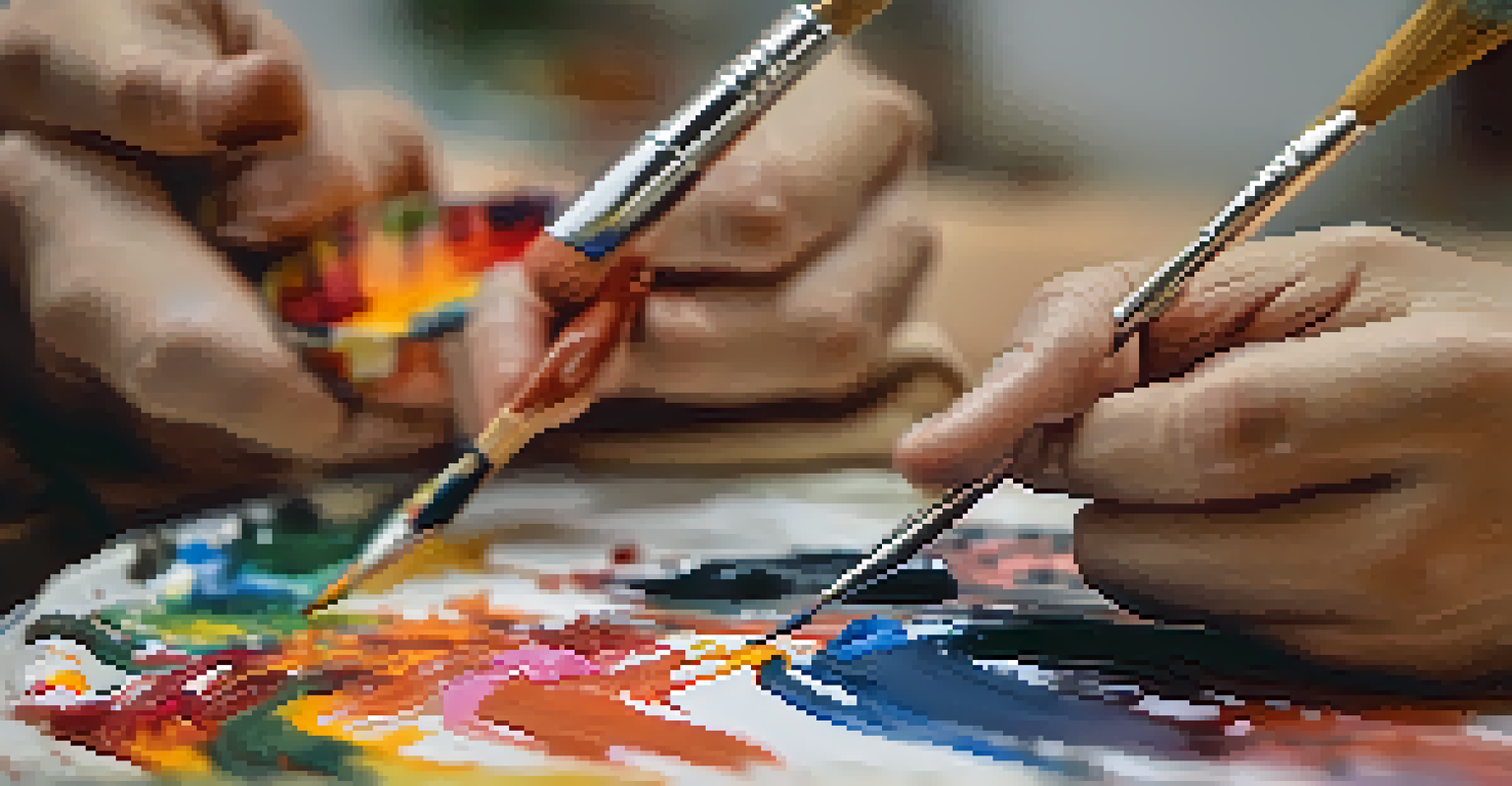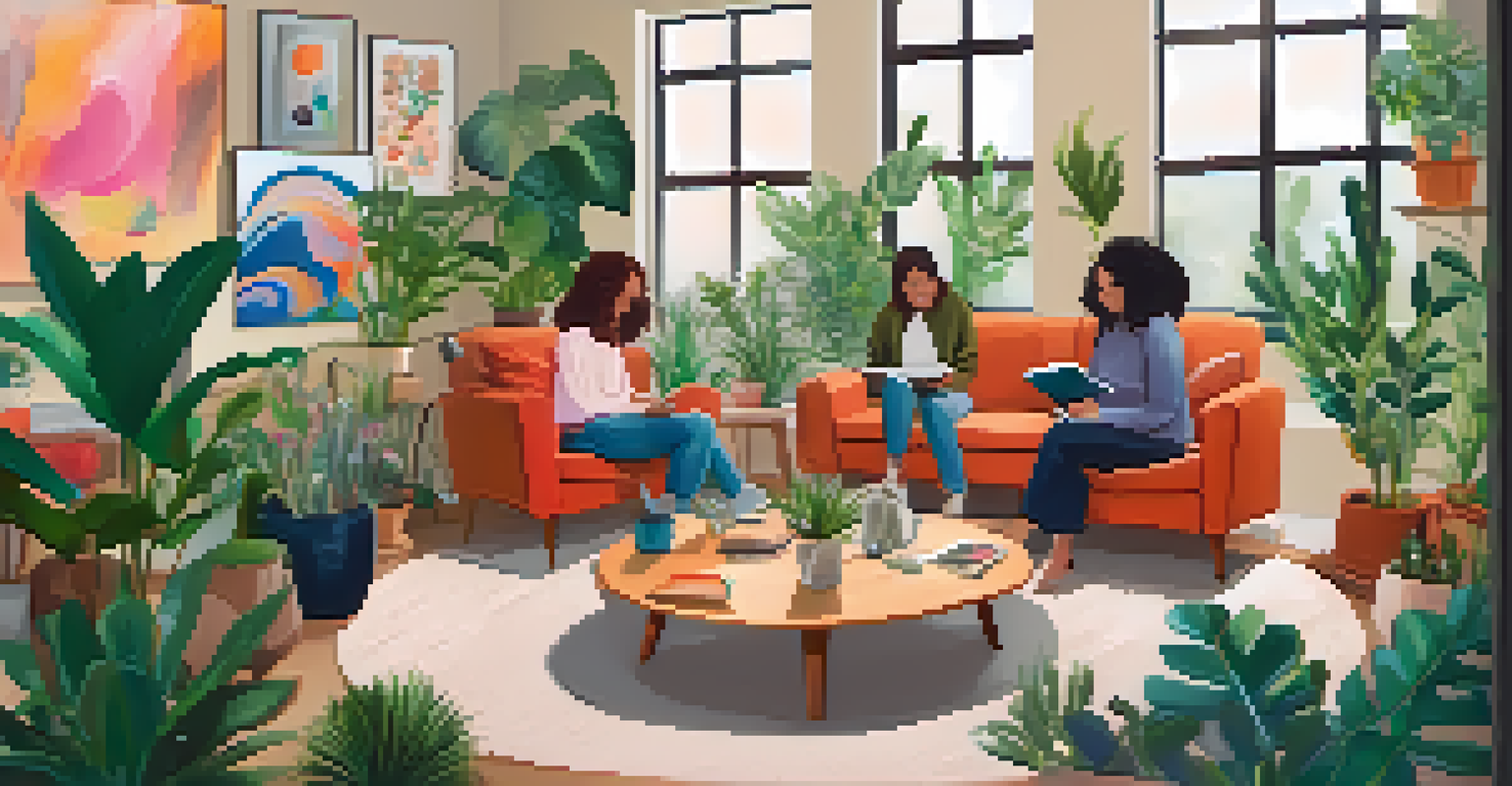Examining the Impact of Art Therapy on Mental Health

Understanding Art Therapy: A Creative Approach to Healing
Art therapy combines creative expression with psychological support, allowing individuals to communicate feelings that might be hard to articulate. It’s not just about painting or drawing; it encompasses various forms of art, including sculpture, music, and dance. This holistic approach helps to foster self-discovery and emotional resilience, making it a unique tool for mental health.
Art is not what you see, but what you make others see.
The process of creating art can be incredibly liberating, providing a safe space for individuals to explore their thoughts and emotions. For many, the act of making art serves as a release, helping to reduce anxiety and stress levels. This therapeutic outlet encourages individuals to express themselves in ways that traditional talk therapy might not, making it especially beneficial for those who struggle with verbal communication.
Art therapy is often facilitated by trained professionals who guide clients through the creative process, ensuring a supportive environment. These therapists understand the emotional nuances that come with creating art and are equipped to help clients navigate their feelings. As a result, participants often leave sessions with a greater sense of clarity and emotional relief.
The Psychological Benefits of Engaging in Art
Engaging in art can lead to a myriad of psychological benefits, such as improved mood and enhanced self-esteem. When individuals create something meaningful, it can instill a sense of accomplishment and pride, which is especially significant for those battling depression or low self-worth. This boost in confidence can lead to a positive feedback loop, encouraging further creative expression.

Moreover, art therapy has been shown to help individuals process traumatic experiences. By externalizing their feelings through art, clients can gain new perspectives on their trauma, which can be incredibly empowering. This safe form of expression allows them to confront and work through their pain in a constructive manner.
Art Therapy Fosters Emotional Healing
Art therapy provides a unique outlet for individuals to express their feelings creatively, aiding in emotional resilience and self-discovery.
In addition, art therapy can foster a sense of community among participants. Group art therapy sessions provide a platform for sharing experiences and support, creating bonds between individuals facing similar struggles. This sense of belonging can be particularly healing for those feeling isolated or alone in their mental health journey.
Art Therapy for Specific Mental Health Conditions
Art therapy has been found effective for various mental health conditions, including anxiety, depression, PTSD, and even schizophrenia. For example, individuals with anxiety often find that the creative process helps to ground them, reducing racing thoughts and promoting mindfulness. This therapeutic practice can serve as a powerful tool in managing symptoms and improving overall well-being.
The painter tries to master color, the sculptor tries to master form, and the artist tries to master himself.
For those dealing with PTSD, art therapy can provide a means of processing traumatic memories without the need for direct confrontation. Participants can explore their feelings through metaphor or symbolism, which can sometimes feel safer than discussing painful experiences outright. This indirect approach can be particularly beneficial in building trust and safety within the therapeutic relationship.
Additionally, art therapy can aid in the recovery of individuals experiencing substance abuse issues. By channeling their emotions into creative outlets, clients can find healthier ways to cope with stress and triggers that may lead to relapse. This creative expression not only supports recovery but also encourages the development of new, positive coping mechanisms.
The Role of Creativity in Mental Health Recovery
Creativity plays a vital role in mental health recovery by fostering resilience and adaptability. Engaging in creative activities can help individuals shift their focus away from negative thought patterns, promoting a more optimistic outlook on life. This shift can be crucial for those in recovery, as it encourages them to envision a future filled with hope and possibility.
Furthermore, the act of creating art can serve as a form of self-care, allowing individuals to prioritize their mental health in a tangible way. Setting aside time for artistic activities can provide a much-needed break from daily stressors, leading to improved emotional regulation. This self-care routine can become an essential part of an individual’s overall mental health strategy.
Creativity Enhances Mental Well-Being
Engaging in creative activities through art therapy can lead to improved mood, self-esteem, and a sense of community among participants.
Moreover, creativity can enhance problem-solving skills by encouraging out-of-the-box thinking. This fresh perspective can be invaluable for individuals facing challenges in their personal or professional lives. As they learn to navigate their creative processes, they also develop skills that can be applied to everyday situations, leading to greater confidence and self-efficacy.
The Science Behind Art Therapy: Research Findings
Numerous studies have demonstrated the positive impact of art therapy on mental health. Research indicates that individuals participating in art therapy experience reductions in anxiety and depression symptoms, along with improvements in overall emotional well-being. These findings support the idea that creative expression can be a powerful adjunct to traditional therapeutic approaches.
One notable study found that participants in art therapy reported heightened feelings of self-acceptance and emotional resilience. This suggests that engaging in artistic activities not only helps in processing emotions but also enhances self-image, which is vital for recovery. The research highlights the importance of integrating art therapy into treatment plans for those struggling with mental health issues.
Additionally, brain scans of individuals engaged in creative activities show increased activity in areas associated with emotional regulation. This reinforces the idea that art therapy can physically alter the way our brains process emotions, making it a potent tool for healing. As more research emerges, the evidence supporting art therapy's efficacy continues to grow, paving the way for its integration into mainstream mental health treatment.
How to Get Started with Art Therapy
If you're considering art therapy, the first step is to find a qualified art therapist. Look for professionals who are licensed and have experience in mental health care, as well as a background in art therapy techniques. Many therapists offer introductory sessions, giving you a chance to see if their approach resonates with you.
Once you find a therapist, be prepared to explore various forms of creative expression. Whether it's painting, sculpting, or even digital art, your therapist will guide you in discovering what medium best suits your needs. Remember, the goal isn't to create a masterpiece but to engage in the process of creation and self-exploration.
Research Supports Art Therapy's Efficacy
Studies show that art therapy significantly reduces symptoms of anxiety and depression while enhancing emotional regulation and self-acceptance.
It's also important to approach art therapy with an open mind and a willingness to express yourself. This journey is personal, and there’s no right or wrong way to create art. By embracing the experience, you can unlock the therapeutic benefits that come from engaging with your emotions through creativity.
The Future of Art Therapy in Mental Health Treatment
As awareness of mental health issues continues to grow, so does the recognition of art therapy as a valuable treatment option. In recent years, more healthcare providers are incorporating creative therapies into their mental health services, acknowledging the importance of holistic approaches. This shift reflects a broader understanding of mental health that values emotional expression as a pathway to healing.
The future of art therapy looks promising, with ongoing research exploring its potential applications in diverse settings, from hospitals to schools. As more studies validate its effectiveness, we may soon see art therapy becoming a standard component of mental health treatment plans. This evolution could lead to increased access to creative therapies for individuals in need.

Furthermore, the rising popularity of online platforms has made art therapy more accessible than ever. Virtual art therapy sessions allow individuals to engage in therapeutic practices from the comfort of their homes, breaking down barriers to access. As technology continues to evolve, the potential for art therapy to reach a wider audience is exciting and could significantly enhance mental health support.